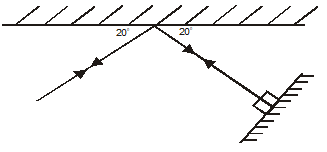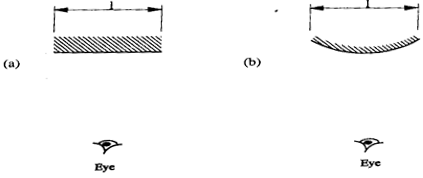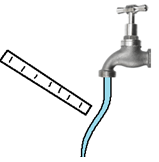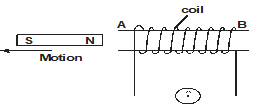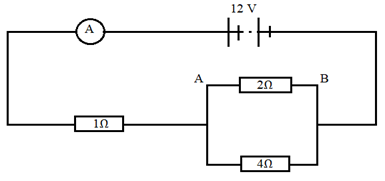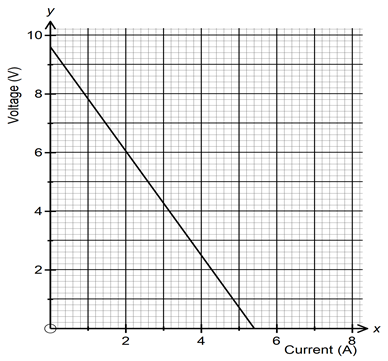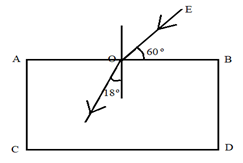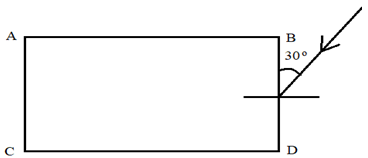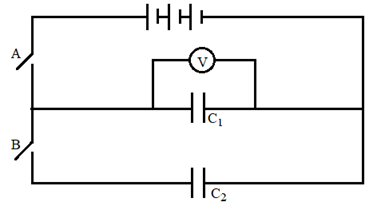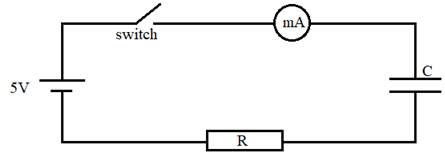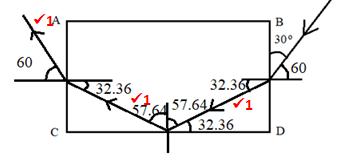INSTRUCTIONS TO CANDIDATES
- Answer ALL the questions in the spaces provided.
- ALL working MUST be clearly shown.
- ALL numerical answers MUST be expressed in decimal forms.
SECTION A (25 Marks)
Answer all the questions in this section in the spaces provided
- The following diagram shows the path of light after striking two mirrors at an angle.
Determine the angle between the two mirrors. (2mark) - The figure shows the eye defect
- Name the defect (1mark)
- State how the defect can be corrected. (1mark)
- Explain why a plain sheet of paper and a plane mirror both reflect light yet only the plane mirror forms images while paper cannot form images. (2 marks)
- What property of light is suggested by the formation of shadows? (1 mark)
- An object placed 15 cm from a convex lens forms an upright image which is magnified two times. Determine the focal length of the lens. (3 marks)
- State one advantage of a lead-acid accumulator over a nickel-iron accumulator. (1 mark)
- An electric bulb rated, 40W is operating on 240 V mains. Determine the resistance of its filament. (3 marks)
- Explain why earthing is necessary in the domestic wiring circuit. (1 mark)
- A positively charged rod is brought near the cap of a leaf electroscope. The cap is the earthed momentarily by touching with the finger. Finally, the rod is withdrawn. The electroscope is found to be negatively charged. Explain how this charge is acquired. (2 marks)
- The force on a conductor carrying a current in a magnetic field can be varied by changing, among others, the magnitude of the current and the magnetic field strength. Name any other factor that can be changed to vary the force. (1 mark)
- The table below carries information on the type of radiation, detector and use for some of the electromagnetic radiations.
Fill in the blank spaces. (2 mark)Type of radiation Detector Use Microwave Crystal detector, solid state diodes Thermopile, blackened bulb thermometer Warmth sensation - The figures below show a convex mirror and a plane mirror of equal aperture
By sketching a pair of incident and reflected rays for each(a) and (b) show how the convex mirror provides to the eye, a wider field of view than a plane mirror. (2marks) - Water is flowing in a very narrow stream from a water tap (faucet). A negatively-chargedplastic strip is held close to the stream of water, as shown in the figure below.
The stream of water moves towards the plastic strip.Explain whythis observation. (2mark)
SECTION B (55 Marks)
Answer all the questions in this section in the spaces provided
-
- State Faradays law of electromagnetic induction. (1 mark)
- The primary coil of a transformer has 1200 turns and the secondary coil has 60 turns. The transformer is connected to a 240V a.c source. Determine
- The output voltage. (3 marks)
- The output current when the primary coil has a current of 0.5A (Assume there is no energy losses)
(3 marks) - One of the primary ways in which power is lost in transformers is through eddy currents. State how eddy currents can be minimized. (1 mark)
- Determine the cost of using an electric iron rated 1500W, for a total of 30 hours given that the cost of electricity per kwh is Ksh 8. (3 marks)
- The figure below shows a coil and a magnet being removed from the coil.
Indicate the direction of flow of current on the coil. (1 mark)
- Study the circuit diagram below and answer the questions that follow
- Calculate
- The current flowing through the ammeter. (3 marks)
- The PD across AB (2 marks)
- The current through the 4Ω (2 marks)
- The graph below shows relationship between voltage and the current obtained from an experiment performed by form 4 students.
- Draw a circuit that could be used to obtain the results shown on the graph. (1 mark)
- From the graph determine the emf of the battery used give the relation E=IR +Ir (3 marks)
- Determine the internal resistance of the battery. (2 marks)
- Calculate
-
- State the conditions necessary for total internal reflection to take place (2 marks)
- A ray of light travelling in the direction EO in air enters a rectangular block at an angle of incidence of 30°. The resulting angle of refraction is 18°.
Find,- The refractive index of the block. (2 marks)
- The critical angle of the block. (2 marks)
- If the ray is incident on surface BD, as shown in the figure
- Complete the diagram to show the path of light throughout the diagram. (2 marks)
- At what angle will the ray leave the block (2 marks)
- The figure below shows a circuit where a battery of 4.5V, switches A and B, two capacitors C1 = 0.3 µF and C2 = 0.5µF and a voltmeter are connected.
-
- Determine the charge on C1 when switch A is closed and switch B opened. (2 marks)
- What is the effective capacitance of the circuit (2 marks)
- What is observed in the voltmeter when;
- Switch A is closed and switch B opened. (1 mark)
- Switch is closed and opened and then switch B is closed. (1 mark)
- Explain the observation made in (b) (ii) above. (2 marks)
- The following figure show a circuit consisting of a resistor that may be used to charge a capacitor.
- State the observation made on the milliammeter when the switch is closed. (1 mark)
- Explain the observation made in (c) (i) above. (2 marks)
- The circuit in the figure is left on for some times. State the value of the Pd across
- Resistor R (1 mark)
- The capacitor C (1 mark)
-
-
- distinguish between a transverse and a longitudinal wave (2marks)
- The diagram shows how displacement varies with time as a wave passes a fixed point. Displacement in metres.
What is the frequency of this wave? (2marks) - Figure below shows a tuning fork producing waves. The wave fronts are as in the diagram.
If the speed of sound in air is 330ms-1, determine the value of d. (3 marks) - The figure below shows wave front in a ripple tank approaching a shallow region in the tank.
Complete the diagram to show the wave front as they pass over shallow region and after leaving the region.
(1 marks)

MARKING SCHEME
- angle =180 − (90+20)= 70°
-
- Long sightedness
- Introducing a concave lens
- The plain sheet of paper absorbs some light while the mirror doesn’t. it reflects all the light.
- Rectilinear propagation of light.
- m=2
2 = v/u → v = 2u
u = 15 cm
v = −30 cm since the image is upright
1/f = 1/u + 1/v
1/f = 1/15 − 1/30
1/f = 2−1 = 1/30
30
f = 30cm - Has a higher emf per cell than nickel-iron accumulator.
- P = VI
40 = 240I
I = 1/6A
R = V/I = 240
1/6
R = 1440Ω - Prevents the risk of electric shock in case of faulty connection of electrical current.
- The positively charged rod attracts the negatives and “repels” the positives.
When earthed, electrons flow from the earth and neutralize the positive charges.
The electroscope acquires negative charge. -
- The angle at which the conductor cuts the magnetic field.
- The length of the conduct
-
Type of radiation Detector Use Microwave Crystal detector, solid state diodes -Radar
- point to point communication links
- wireless networks
- remote sensingInfrared Thermopile, blackened bulb thermometer Warmth sensation
- The negative charges induce positive charges on water by repelling the negative charges. This causes the stream to be attracted towards the rod
-
- Whenever there is change of magnetic flux an emf is induced whose magnitude is proportional to the rate of change of flux ✔1
-
- Vs = Ns ✔1
Vp Np
60 = Vs ✔1
1200 240
Vs=12V✔1 - Power Input = Power Output
VI = Power Output ✔1
240 × 0.5 = 12 × I ✔1
I = 10A ✔1 - by laminating the core ✔1
- Vs = Ns ✔1
- E = Pt
E = 1.5 × 30 = 45kwh ✔1
Cost = (45 × 8)sh ✔1
= Shs 360 ✔1 -
✔1 for correct arrow directions
-
-
- R = 2 × 4 +1 ✔1
6
= 1.333 + 1
= 2.333Ω✔1
I = 12
2.333
= 5.144A✔1 - V = IR
= 1.333 × 5.144 ✔1
= 6.857 V✔1 - I = 6.857✔1
4
= 1.7143A ✔1
- R = 2 × 4 +1 ✔1
-
-
- V = −Ir + E ✔1
E = V intercept ✔1
= 9.6 V (±0.1) ✔1 - Internal resistance = gradient
= 9.6 − 0
0 − 5.4 ✔1
=1.778Ω (± 0.2) ✔1
-
-
-
-
- The angle of incidence must exceed the critical angle ✔1
- Light must travel from optically denser to a rarer medium.✔1
-
- n = sin 30 ✔1
sin 18
= 1.6180✔1 - sin c = 1/n ✔1
sin c = 1 ✔1
1.618
c = 38.17°✔1
- n = sin 30 ✔1
-
-
- sin 60 =1.6180 ✔1
sin r
sin r = sin 60 ✔1
1.6180
r = 32.36° ✔1
-
-
-
-
- Q = CV ✔1
= 0.3 × 4.5 ✔1
=1.35μC ✔1 - C= C1 +C2 ✔1
0.3 + 0.5 = 0.8μF ✔1
- Q = CV ✔1
-
- the reading of the voltmeter increases from zero to attain a maximum of 4.5V ✔1
- the reading increases to 4.5V then decreases to a lower value. ✔1
- C1 is charged by the battery Pd increases until the capacitor is fully charged. ✔1
-
- deflects then reduces to zero ✔1
- electrons flow from plate A of the capacitor towards the positive terminal of the battery. ✔1
-
- 0V ✔1
- 5V ✔1
-
-
-
- Transverse-vibration of wave particles is perpendicular to the direction of wave motion ✔1
- Longitudinal- displacement of the wave particles is perpendicular to the direction of the wave motion ✔1
- f = 1/T ✔1
= ½
= 0.5Hz ✔1 - 330 ✔1
512
= 0.6445m ✔1
d = 0.6445 × 2.5=1.6113m ✔1 -
-
Download Physics Paper 2 Questions and Answers - Pavement Mock Exams 2021/2022.
Tap Here to Download for 50/-
Get on WhatsApp for 50/-
Why download?
- ✔ To read offline at any time.
- ✔ To Print at your convenience
- ✔ Share Easily with Friends / Students

